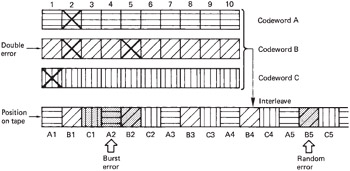3.20 Product Codes
| | ||
| | ||
| | ||
3.20 Product Codes
In the presence of burst errors alone, the system of interleaving works very well, but it is known that in most practical channels there are also uncorrelated errors of a few bits due to noise. Figure 3.36 shows an interleaving system where a dropout-induced burst error has occurred which is at the maximum correctable size . All three codewords involved are working at their limit of one symbol. A random error due to noise in the vicinity of a burst error will cause the correction power of the code to be exceeded. Thus a random error of a single bit causes a further entire symbol to fail. This is a weakness of an interleaving system designed solely to handle dropout-induced bursts. Practical high-density equipment must address the problem of noise-induced or random errors and burst errors occurring at the same time. This is done by forming codewords both before and after the interleave process. In block interleaving, this results in a product code , whereas in the case of convolutional inter-leave the result is called cross-interleaving .

Figure 3.36: The interleave system falls down when a random error occurs adjacent to a burst.
Figure 3.37 shows that in a product code the redundancy calculated first and checked last is called the outer code, and the redundancy calculated second and checked first is called the inner code. The inner code is formed along tracks on the medium. Random errors due to noise are corrected by the inner code and do not impair the burst-correcting power of the outer code. Burst errors are declared uncorrectable by the inner code which flags the bad samples on the way into the deinterleave memory. The outer code reads the error flags in order to correct the flagged symbols by erasure. The error flags are also known as erasure flags. As it does not have to compute the error locations, the outer code needs half as much redundancy for the same correction power. Thus the inner code redundancy does not raise the code overhead. The combination of codewords with interleaving in several dimensions yields a truly synergistic error-protection strategy, in that the end result is more powerful than the sum of the parts . This technique is used in the FEC strategy for delivering audio over ATM.

Figure 3.37: In addition to the r edundancy P on rows, inner redundancy Q is also generated on columns . On replay , the Q code checker will pass on flags F if it finds an error too large to handle itself. The flags pass through the de-interleave pr ocess and are used by the outer error correction to identify which symbol in the row needs correcting with P redundancy. The concept of crossing two codes in this way is called a product code.
| | ||
| | ||
| | ||
EAN: 2147483647
Pages: 120